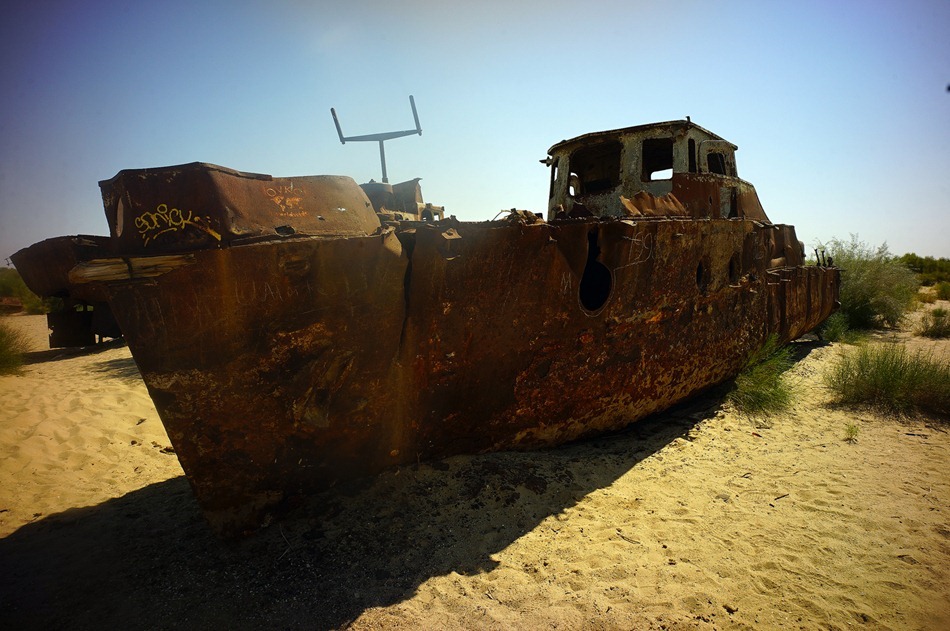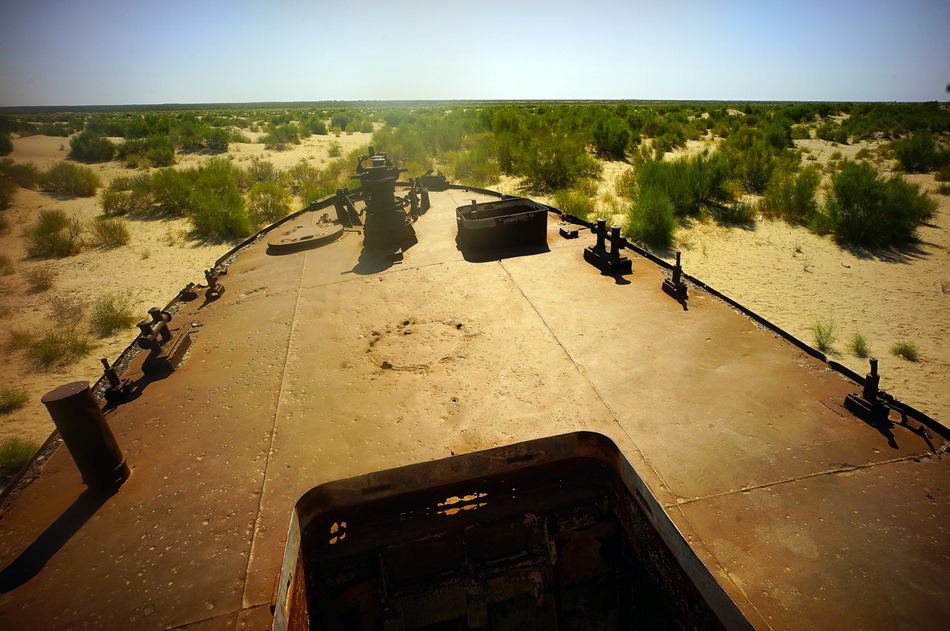Below is the view of the vast expanse of the Aral Sea, seen from the bow of a fishing boat.
Or at least that’s what you would’ve seen had you been on this boat, at this spot, 50 years ago.

Now the Aral Sea has all but vanished. Uzbekistan and Kazakhstan’s cotton industries soaked up all the water faster than the rivers draining into the Aral could replenish it, and by the 1970s most of its finishing industry had perished.

Now, the shores of the Aral Sea, which is more like a pond these days, are some 200km away from where I took these photos.

The small village of Moynaq, once the center of Uzbekistan’s Aral Sea fishing industry, is a sad, desertified little collection of buildings, and there’s not much going on there aside from the small collection of rusting fishing boat hulls you can visit at the edge of town.

As well as a monument showing the progressive retreat of the Aral over the past few decades.

To get to what remains of the watery part of the Aral Sea, you have to hire a 4x4 for $500 to take you out into what is now a roadless desert. Once there, I’ve heard that the water is so densely salty that your body floats right on top of it almost as if it was a solid rather than a liquid.

Needless to say, I did not spend $500 just to do that, so instead I contented myself with climbing around on the derelict ships and trying not to die of heatstroke.

It was just about one of the saddest things I’ve ever seen; what was once a relatively green, thriving economic center completely destroyed by careless environmental neglect.

There is actually no sign that there was ever water here. You’d be forgiven for thinking that Moynaq was just a poorly-placed little village and that some prankster had put the rusty ships there as some kind of avant-garde installation piece.

Most people have already left the area and moved on with their lives; in 50 years it won’t even seem like such a big deal that a whole sea just completely up and vanished.


Here’s me at the recently constructed monument. You can sea the sweat glistening on my neck. It had to have been over 100 degrees F.

This old-timer probably remembers everything. Maybe he was even a fisherman.

My taxi driver was content to shuttle me and three Uzbeks the 80km back and forth from Kungrad to Moynaq though…He and his sad little bunny didn’t seem phased at all by the missing ocean. I guess life goes on.
I don’t really feel like I have much commentary to add to the Aral Sea discussion…When I was in Moynaq, I felt a vague sense that I was partaking in disaster tourism, akin to visiting the killing fields in Cambodia or the Nagasaki A-bomb memorial in Japan. It’s really interesting, but I also felt a bit guilty.
For a great write-up and photo gallery, check out National Geographic’s Aral Sea article.
Or at least that’s what you would’ve seen had you been on this boat, at this spot, 50 years ago.

Now the Aral Sea has all but vanished. Uzbekistan and Kazakhstan’s cotton industries soaked up all the water faster than the rivers draining into the Aral could replenish it, and by the 1970s most of its finishing industry had perished.

Now, the shores of the Aral Sea, which is more like a pond these days, are some 200km away from where I took these photos.

The small village of Moynaq, once the center of Uzbekistan’s Aral Sea fishing industry, is a sad, desertified little collection of buildings, and there’s not much going on there aside from the small collection of rusting fishing boat hulls you can visit at the edge of town.

As well as a monument showing the progressive retreat of the Aral over the past few decades.

To get to what remains of the watery part of the Aral Sea, you have to hire a 4x4 for $500 to take you out into what is now a roadless desert. Once there, I’ve heard that the water is so densely salty that your body floats right on top of it almost as if it was a solid rather than a liquid.

Needless to say, I did not spend $500 just to do that, so instead I contented myself with climbing around on the derelict ships and trying not to die of heatstroke.

It was just about one of the saddest things I’ve ever seen; what was once a relatively green, thriving economic center completely destroyed by careless environmental neglect.

There is actually no sign that there was ever water here. You’d be forgiven for thinking that Moynaq was just a poorly-placed little village and that some prankster had put the rusty ships there as some kind of avant-garde installation piece.

Most people have already left the area and moved on with their lives; in 50 years it won’t even seem like such a big deal that a whole sea just completely up and vanished.


Here’s me at the recently constructed monument. You can sea the sweat glistening on my neck. It had to have been over 100 degrees F.

This old-timer probably remembers everything. Maybe he was even a fisherman.

My taxi driver was content to shuttle me and three Uzbeks the 80km back and forth from Kungrad to Moynaq though…He and his sad little bunny didn’t seem phased at all by the missing ocean. I guess life goes on.
I don’t really feel like I have much commentary to add to the Aral Sea discussion…When I was in Moynaq, I felt a vague sense that I was partaking in disaster tourism, akin to visiting the killing fields in Cambodia or the Nagasaki A-bomb memorial in Japan. It’s really interesting, but I also felt a bit guilty.
For a great write-up and photo gallery, check out National Geographic’s Aral Sea article.
